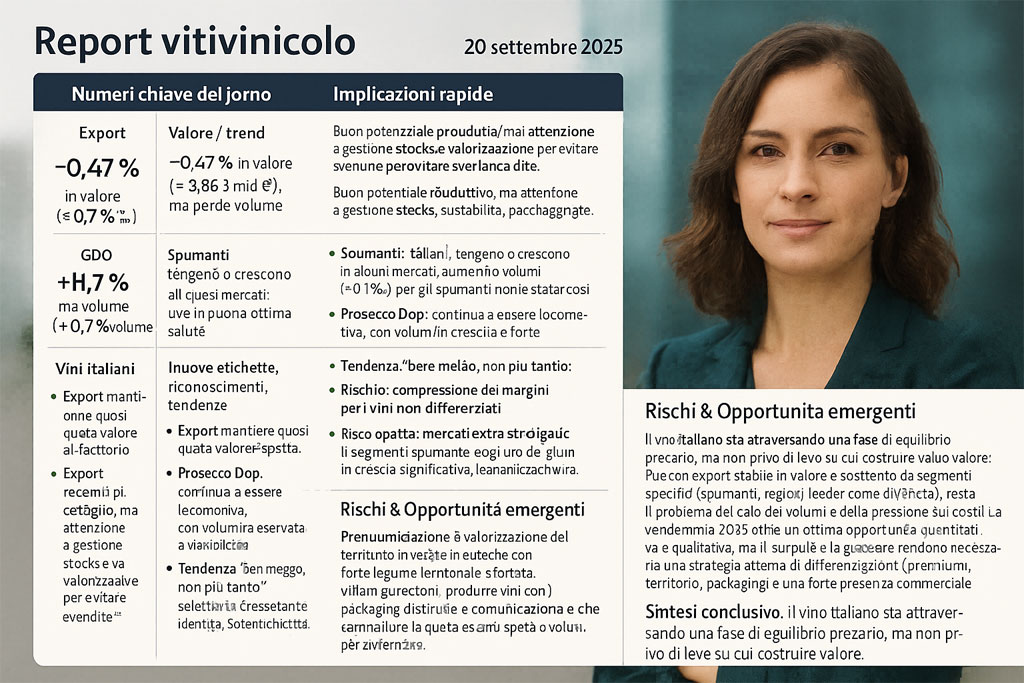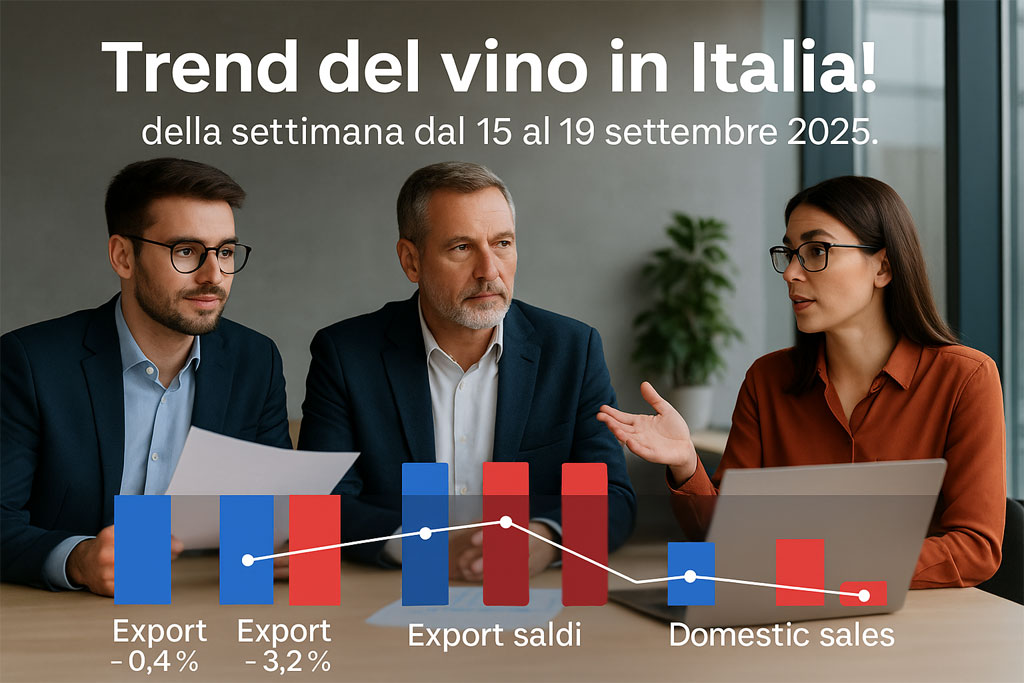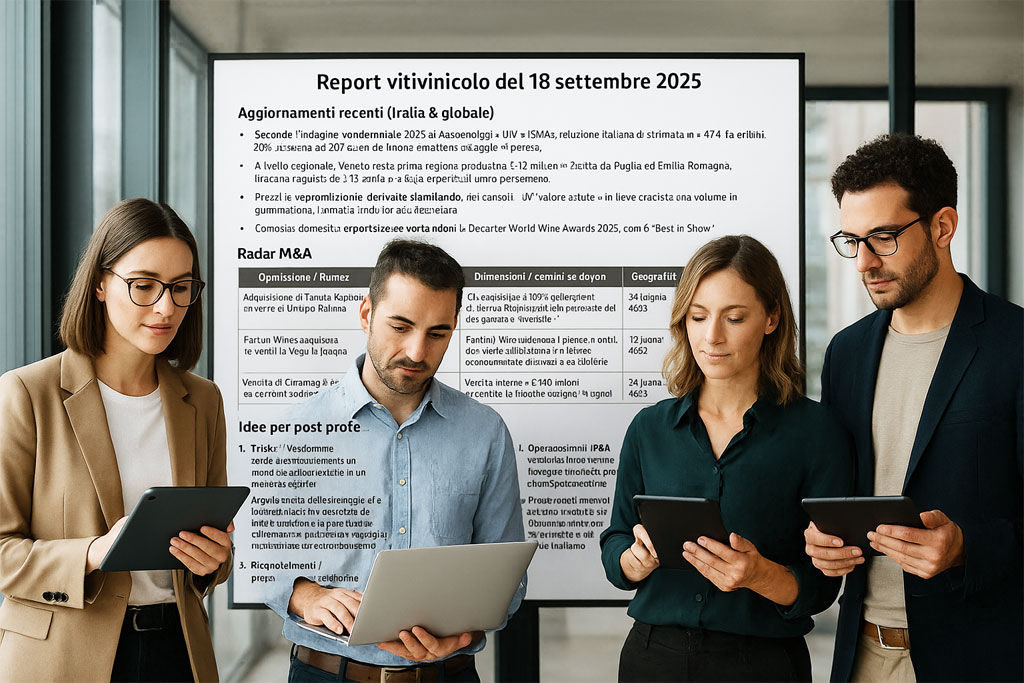Wine report for today, September 20, 2025, with updated data and operational analysis to support your acquisition, sale, or positioning decisions.
Key numbers of the day
| Metrics | Value / trend | Quick implications |
|---|---|---|
| Wine exports (first half of 2025 vs 2024) | -0.47% in value (≈ €3.86-3.87 billion), -3.1% in volume. | Exports are close to breakeven, but the loss of volume exposes margin risks; focus is needed on premium segments and growing markets. |
| 2025 Harvest (Expected Production and Quality) | ≈ 47.4 million hectoliters, 8% compared to 2024; grapes in good-excellent health. | Good production potential, but attention must be paid to stock management and valuation to avoid sell-offs. |
| Large-scale retail trade, sparkling wines & internal channel | Italian large-scale retail trade holds up in value (0.7% in the last 12 months), but loses volume (-2.5%); sparkling wines 7.6% in volume in many cases. | A modern channel remains essential; sparkling wines are a driving force: invest in packaging, promotion, and premiums for differentiation. |
Italian wineries (news, strategies, mergers, events)
- No significant mergers have been reported recently; the prevailing strategy is to differentiate between quality and terroir rather than aggregation. Various sources emphasize that many wineries are focusing on improved agricultural practices, territorial identity, and certifications.
- Some wineries are putting pressure on their contractors/suppliers (e.g. in Trentino) to adjust their remunerations, given the rising costs and pressure on margins.
- Recent noteworthy events: Sip of Italy / Wine Enthusiast in New York with over 300 Italian labels, an opportunity for international visibility.
Italian wines (new labels, awards, trends)
- Italian sparkling wines: holding steady or growing in some markets; volumes of sparkling wines increase (0.1%) despite a slight decline in overall value.
- Prosecco DOP: continues to be a driving force, with growing volumes and a strong presence on foreign markets.
- White and sparkling wines in large-scale retail trade: still white wines and sparkling wines are the best-performing categories in many large-scale retail channels; red and sparkling wines are suffering losses in volume.
- The trend of “drinking better, not as much”: consumers are becoming increasingly selective, prioritizing identity, sustainability, packaging, and authenticity.
Italian wine trends (exports, consumption, economic data)
- Exports maintain almost the same value share as in 2024 (-0.47%), but volumes are decreasing: -3.1%.
- The 2025 harvest promises good quantities (8%) and high quality, but with significant stocks (cellars already have high stocks) which require the domestic and foreign markets to absorb the surplus.
- Regional: Veneto consolidates its export leadership (1.5% value, approximately €1.4 billion). Tuscany and Piedmont slightly decline in value.
- Large-scale retail trade: stable or slightly growing in value; volume losses, especially for generic wines, non-premium reds, and larger formats. Sparkling wines and white wines are the most resilient categories.
Emerging Risks & Opportunities
Here they are, with practical suggestions for interventions that can make a difference:
- Opportunities: Premiumization & Territorial Enhancement Investing in labels with strong territorial ties, historical heritage, and native grape varieties; producing wines with distinctive packaging and storytelling communication can yield higher margins in foreign markets.
- Opportunity: Sparkling Wines as a Strategic Lever The sparkling wine segment is currently one of the few experiencing significant growth; wineries with production capacity, reputation, and quality control can increase their export/domestic spending share by leveraging this category.
- Risk: Margin Compression for Non-Differentiated Wines Generic wines, non-premium reds, and large or bulk formats risk seeing margins eroded by energy costs, tariffs, and unfavorable exchange rates. It’s important to evaluate whether to continue in these segments or reorient.
- Opportunities: Non-EU markets and geographic diversification. Positive signs from Canada, the USA (despite tariffs), and Australia. Asian markets are declining in some cases, but demand for quality remains high. Strengthening sales, logistics, and brand awareness in those markets showing growth is worthwhile.
- Risk: Inventory and Average Price Management With the harvest increasing and stocks already large, those who do not monitor the unit cost/price ratio may find themselves forced to discount, promotional offers or sales below cost, which damage their positioning.
Final summary
Italian wine is experiencing a precarious balance , but it’s not without levers for building value. Despite stable exports in value and supported by specific segments (sparkling wines, leading regions like Veneto), the challenge of declining volumes and cost pressures remains. The 2025 harvest offers an excellent opportunity in terms of both quantity and quality, but the surplus and inventory necessitate a careful differentiation strategy (premium, terroir, packaging) and a strong commercial presence in markets that reward these characteristics.





